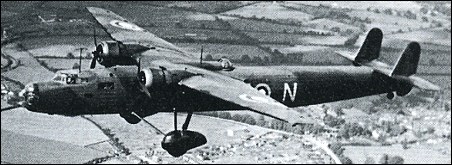|
| Not to be confused with the Harrow two-seat general-purpose torpedo bomber of 1926, the Harrow bomber was a cantilever high-wing monoplane with a fixed divided-type landing gear and a twin fin and rudder-type tail unit. Enclosed accommodation was provided for a normal flight crew of four, who were also expected to man the nose turret, tail turret and mid-upper gun position.
A total of 100 Mk I and Mk II Harrows were ordered in August 1935, differing in having two 618kW Bristol Pegasus X and 689kW Pegasus XX engines respectively.
With the arrival of the Wellington, Harrows were converted into 20-troop or freight-carrying transports, although a number performed mine-laying duties during the early part of World War II.
| ENGINE | 2 x Bristol Pegasus XX, 690kW |
| WEIGHTS |
| Take-off weight | 10433 kg | 23001 lb |
| Empty weight | 6169 kg | 13600 lb |
| DIMENSIONS |
| Wingspan | 26.95 m | 88 ft 5 in |
| Length | 25.04 m | 82 ft 2 in |
| Height | 5.92 m | 19 ft 5 in |
| Wing area | 101.26 m2 | 1089.95 sq ft |
| PERFORMANCE |
| Max. speed | 322 km/h | 200 mph |
| Cruise speed | 262 km/h | 163 mph |
| Ceiling | 6950 m | 22800 ft |
| Range | 2010 km | 1249 miles |
| ARMAMENT | 4 x 7.7mm machine-guns, 1360kg of bombs |
 | A three-view drawing (678 x 560) |
| David Green, e-mail, 03.01.2021 06:15 Love the Harrow- hugely. Wondering if anyone has any data on any Harrow Operational Squadron Codes, with their associated aircraft identifying letters, together with the associated fuselage serial numbers? Example: Harrow aircraft, 214 'G' (what was its fuselage serial number?) Harrow aircraft, 214 'M' (what was its fuselage serial number?) Any data that helps to match up Squadron Codes with individual aircraft identification letters and serial numbers, would be hugely appreciated.
Thanks in advance. reply | | bombardier, e-mail, 17.05.2011 11:21 This aircraft with retractable undercarriage and Bristol Taurous or Hercules engines would have been an excellent and
very effective night bomber like the Whitley reply | | Barry, 15.03.2011 17:39 Paul Brown the photograph you saw was the early experiments of Sir Alan Cobham. He later went on to form Flight Refuelling Ltd ( Later Cobham Ltd) which still exists today as a world leader in flight refuelling. reply | | paul brown, e-mail, 30.05.2010 19:27 Looked this aircraft up today as in an old aviation book of mine I saw a photograph of one. This showed a Harrow refuelling a Short produced flying boat in a trial run. I was surprised air to air refuelling was tried so early. reply | |
| | Patrick Thomas Connolly, e-mail, 10.05.2008 16:46 Dear Ian Woodford, May 10, 2008.
I was amazed to read your My father was a navigator and from June 15 to the 29th, 1943 he made some 28 flights in 'Harrow K7005' piloted by F /O Roberts (his regular pilot up to October 30). On December 5 1943 he flew 'Sparrow K6978' piloted by F /L Edgehill and he did not fly again until December 23 when he flew in 'Sparrow K6970' piloted by F /L Robertson.
My father, Thomas W. Connolly, was in RAF's 271 Sqdn. from April 16, 1943 to September 17, 1944.
I have a copy of his log book. He gives the names of his pilots but I would like to fill in a few names of the other people he flew with.
Other Harrow /Sparrow pilots he flew with were P /O Swaby, W /O Lezard, F /O Wilson, W /O Mruk, F /S Greenwell, F /L Geilogowd, P /O Price W /O Witas, and F /S (W /O) Twiston-Davies who also piloted a glider tow to Arnhem with him in a Dakota.
Thank you, Patrick Thomas Connolly. reply | | Ian Woodford, e-mail, 24.11.2007 14:29 Hi
I've been researching the loss of Harrow K7005 during transport duties with 271 Sqn. The aircraft took off in fog from Eglinton (now Londonderry) airfield on 14th December 1943 and crashed into a mountain in Eire killing 4 of the five on board. My Great Uncle was an airman who lost his life that day. The fifth airman was the pilot, who survived the crash and is still alive today.
I have, along with another relative of one of the deceased, been to the crash site and found the remains of the aircraft buried just underneath the ground, very well preserved by the peaty soil.
My question for you is: do you have any knowledge of a cutaway drawing ever having been done of the type, because I have a couple of items from the wreckage that I want to try and place.
Many thanks
Ian Woodford. reply |
|
Do you have any comments?
|
| 
COMPANY
PROFILE
All the World's Rotorcraft
|








